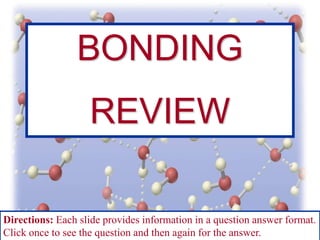
Bonding 2005
- 1. BONDING REVIEW Directions: Each slide provides information in a question answer format. Click once to see the question and then again for the answer.
- 2. Bonds Between Atoms Polyatomic Ions Ionic Covalent Molecular Substance Metallic Network Solids Polar Nonpolar What are we going to learn about??? Coordinate Covalent
- 3. See if you can define the following words before starting the lesson… • Anion- negative ion • Cation-positive ion • Octet Rule- rule that states that atoms tend to gain, lose, or share electrons so that each atom has full outermost energy level which is typically 8 electrons. • Polyatomic Ion- charged group of covalently bound atoms • Monatomic Ion- ion formed from a single atom • Molecule-neutral group of atoms united by covalent bonds • Alloy- homogeneous mixture of metals • Unshared Pair- pair of electrons that is not involved in bonding but instead is held exclusively by one atom.
- 4. Marriage Forming of a bond is like marriage •More stable •exothermic Divorce •Less stable •Endothermic The breaking of a bond relates to a divorce.
- 5. Ionic Bonds •What is an Ionic Bond? - An Ionic Bond is a chemical bond resulting from the TRANSFER of electrons from one bonding atom to another • When is an ionic bond formed? - An ionic bond is formed when a cation (positive ion) transfers electrons to an anion (negative ion).
- 6. What are some characteristics of an ionic bond? 1. 2. 3. 4. Crystalline at room temperatures Have higher melting points and boiling points compared to covalent compounds Conduct electrical current in molten or solution state but not in the solid state Polar bonds
- 7. Covalent Bonds •What is an Covalent Bond? - A covalent bond is a chemical bond resulting from SHARING of electrons between 2 bonding atoms. • What forms a covalent bond? - A covalent bond is formed between two nonmetals.
- 8. What are some characteristics of a covalent bond? 1. 2. 3. Covalent bonds have definite and predicable shapes. Very strong Low melting and boiling points
- 9. Covalent Bonds can have multiple bonds, so you should be familiar with the following… Single Covalent Bondchemical bond resulting from sharing of an electron pair between two atoms. Double Covalent Bondchemical bond resulting from sharing of two electron pairs between two atoms. Triple Covalent Bondchemical bond resulting from sharing of three electron pairs between two atoms.
- 10. There are five different categories associated with covalent bonds. What are the 5 different categories? Covalent Molecular Substance Network Solids Polar Nonpolar Coordinate Covalent
- 11. First, we are going to look at Polar Covalent… What is polar covalent? -Polar covalent is a description of a c bond that has an uneven distribution of charge due to an unequal sharing of bonding electrons. The boy is not equally sharing with anyone else but rather taking all the food for himself.
- 12. Next, we are going to look at Non-Polar Covalent… What is non-polar covalent? -Non polar covalent is a covalent bond that has an even distribution of charge due to an equal sharing of bonding electrons. This couple is non- polar because they are sharing the drink equally between them.
- 13. Next, we are going to look at Molecular Substances… What is a molecular substance? -A molecular substance is a substance that has atoms held together by covalent bonds. Name 2 Characteristics of a Molecular Substance. 1. Weak 2. Low melting and boiling points
- 14. Next, we are going to look at Coordinate Covalent… What is a Coordinate Covalent Bond? -A coordinate covalent bond is a bond formed when one atom donates both electrons that are shared. People donate their blood to help others just like atoms “donate” electrons to form stable octets. *Think about the party analogy!
- 15. Now, we are going to look at Network Solids… What is a Network Solid? -A network solid is a solid that has covalently bonded atoms linked in one big network or one big macromolecule. Name 3 Characteristics of a Network Solid. 1. Poor conductors of heat and electricity 2. Hard / Strong 3. High melting and boiling points Diphenylglycoluril assembles into a unique, twodimensional hydrogen bonding network in the solid state, while exhibiting a twisted molecular structure.
- 16. Metallic Bonding What is a Metallic Bond? - A metallic bond occurs in metals. A metal consists of positive ions surrounded by a “sea” of mobile electrons. This shows what a metallic bond might look like. Name 4 Characteristics of a Metallic Bond. 1. Good conductors of heat and electricity 2. Great strength 3. Malleable and Ductile 4. Luster
- 17. Polyatomic Bonds Polyatomic ions usually have a charge because the collection of atoms has either gained an extra electron or else it has lost an electron. What is a Polyatomic Bond? - A polyatomic bond is charged group of covalently bonded atoms. It is made up of more than one atom.
- 19. Just as a summary to what each bond looks like…
- 20. REVIEW Now that you have completed the review provided you may wish to practice for your test by answering the following regents questions. The question is presented in the same way that http://regentsprep.org/ does them. If you would like to get reasons to why your answers were incorrect you can find the explanations there. After you have gotten your answer, click the mouse and the right answer will show up.
- 21. If you chose…
- 22. If you chose…
- 23. If you chose…
- 24. If you chose…
- 25. If you chose…
- 26. If you chose…
